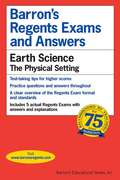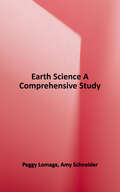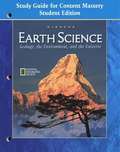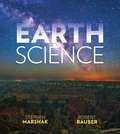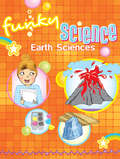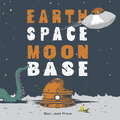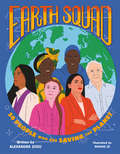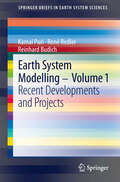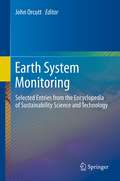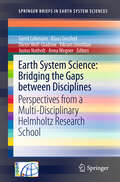- Table View
- List View
Earth Science and Applications from Space: A Midterm Assessment of NASA's Implementation of the Decadal Survey
by Committee on the Assessment of NASA's Earth Science ProgramUnderstanding the effects of natural and human-induced changes on the global environment and their implications requires a foundation of integrated observations of land, sea, air and space, on which to build credible information products, forecast models, and other tools for making informed decisions. The 2007 National Research Council report on decadal survey called for a renewal of the national commitment to a program of Earth observations in which attention to securing practical benefits for humankind plays an equal role with the quest to acquire new knowledge about the Earth system. NASA responded favorably and aggressively to this survey, embracing its overall recommendations for Earth observations, missions, technology investments, and priorities for the underlying science. As a result, the science and applications communities have made significant progress over the past 5 years. However, the Committee on Assessment of NASA's Earth Science Program found that the survey vision is being realized at a far slower pace than was recommended, principally because the required budget was not achieved. Exacerbating the budget shortfalls, NASA Earth science programs experienced launch failures and delays and the cost of implementing missions increased substantially as a result of changes in mission scope, increases in launch vehicle costs and/or the lack of availability of a medium-class launch vehicle, under-estimation of costs by the decadal survey, and unfunded programmatic changes that were required by Congress and the Office of Management and Budget. In addition, the National Oceanic and Atmospheric Administration (NOAA) has made significant reductions in scope to its future Earth environmental observing satellites as it contends with budget shortfalls. Earth Science and Applications from Space: A Midterm Assessment of NASA's Implementation of the Decadal Survey recommends a number of steps to better manage existing programs and to implement future programs that will be recommended by the next decadal survey. The report also highlights the urgent need for the Executive Branch to develop and implement an overarching multiagency national strategy for Earth observations from space, a key recommendation of the 2007 decadal survey that remains unfulfilled.
Earth Science, Alabama, Grade 6
by Mcgraw-Hill EducationThis Alabama Edition of Earth Science for Grade 6 contains lessons on: Unit 1: Exploring Earth, Unit 2: Geologic Changes, Unit 3: Weather and Climate, Unit 4: Water and Other Resources, Unit 5: Exploring the Universe.
Earth Science, The Physical Setting (Barron's Regents Exams And Answers)
by Edward J. DeneckeThis edition includes the most recent Earth Science Regents tests through August 2017. These ever popular guides contain study tips, test-taking strategies, score analysis charts, and other valuable features. They are an ideal source of practice and test preparation. The detailed answer explanations make each exam a practical learning experience.
Earth Science-A Comprehensive Study The Physical Setting
by Amy Schneider Peggy LomagaThis book teaches you how to solve your toughest homework problems. Our resource for Earth Science: The Physical Setting includes answers to chapter exercises, as well as detailed information to walk you through the process step by step. With expert solutions for thousands of practice problems, you can take the guesswork out of studying and move forward with confidence.
Earth Science: A Study of a Changing Planet
by Robert B. Daley W. John Higham George F. MatthiasThe major change the authors hope to accomplish is to help students develop a new way of looking at, and studying, the earth. Students can then use their observations to make intelligent conclusions, or inferences they have learned.
Earth Science: Geology, The Environment, and The Universe (Oklahoma)
by Francisco Borrero Frances Scelsi Hess Chia Hui Juno HsuStrong support for reading comprehension makes earth science accessible to all students.
Earth Science: Grades 9-12
by Pearson Prentice HallPrentice Hall Science Explorer, the nation's leading middle school science program, is the perfect fit for today's classroom. The book provides students with more options so they can deliver lessons aligned to their standards and preferences.
Earth Science: Study Guide for Content Mastery
by McGraw-HillThis Study Guide for Content Mastery for Earth Science: Geology, the Environment, and the Universe will help you learn more easily from your textbook. Each textbook chapter has six study guide pages of questions and activities for you to complete as you read the text. These activities will help you understand the "big picture" of the chapter. The study guide pages are divided into sections that match those in your text. These pages will help you learn the vocabulary and main ideas of the sections. Each GeoDigest in your textbook has two study guide pages to complete.
Earth Science: The Earth, The Atmosphere, and Space
by Stephen Marshak Robert RauberThe leading authors in their respective fields--physical geology and extreme weather--Stephen Marshak and Robert Rauber bring years of classroom and research experience to this remarkable new book and media package. The authors' narrative approach to the content and innovative integration of new visual and interactive resources guides students to a clearer, more applicable understanding of the entire Earth System.
Earth Science: The Physical Setting
by Jeffrey C. CallisterThis book is designed to enhance review of the concepts, skills, and application of the Physical Setting/Earth Science Core Curriculum that may be tested on the Regents Examination for The Physical Setting: Earth Science. Students can use the book in any order as each topic is independent except for the introduction of vocabulary words.
Earth Science: The Physical Setting
by Thomas McGuireEarth Science: The Physical Setting, Second Edition, which follows the New York State Core Curriculum, which is based on National Standards, is an introduction to the study of Earth Science. The specific standards covered in each chapter are listed in the table of contents and next to the text to which they apply and next to each Student Activity. With this book, you can gain a firm understanding of the fundamental concepts of Earth Science--a base from which you may confidently proceed to further studies in science and enjoy a deeper appreciation of the world around you.
Earth Science: The Physical Setting
by Thomas McguireThis book helps students understand the fundamental concepts of earth science and become familiar with the Earth Science.
Earth Sciences Funky Science (Funky Science)
by Kirsten HallSmart and savvy girls will love discovering the secrets of science! Funky Science: Earth Sciences has loads of cool, creative experiments presented in a fun and accessible way, relating to topics that girls love. Glam it up with home-grown crystals, reveal the wonders of magnetic attraction, get down and learn about the amazing ground beneath your feet, and rock out to the beat of amazing Earth Sciences. All experiments are developed with science teachers and provide the science behind the activity along with parental guidance symbols and glossaries of Wonder Words.
Earth Space Moon Base
by Ben Joel PriceOuter space, a moon base, and . . . bananas? Discover Ben Joel Price's quirky extraterrestrial world and its unusual trio of guardians. A spaceman, a robot, and a cheeky monkey use a most unusual method to protect Earth from hungry, googly-eyed moon aliens. Ben Joel Price's offbeat rhymes and colorful, retro-style illustrations evoke a funny little world away from ours, which will captivate readers young and old.
Earth Squad: 50 People Who Are Saving the Planet
by Alexandra ZissuJoin fifty inspiring and extraordinary environmental crusaders working to save our planet and see how you can make a difference just like them. Kids across the globe will be moved by the passion of these amazing eco-warriors who have dedicated their lives to making our world a better place. Alongside dynamic illustrations and entertaining biographical information, you'll find practical tips that anyone can do to help save the earth. Every one of us can make a difference, and, together as an Earth Squad, we can change the world.Will Allen * Anohni * Yann Arthus-Bertrand * Inka Saara Arttijeff * David Attenborough * Precious Brady-Davis * Erin Brockovich * Vicki Buck * Rachel Carson * Yvon Chouinard * Opha Pauline Dube * Lamya Essemlali * Christiana Figueres * Eileen Fisher * Eunice Newton Foote * Wan Gang * Al Gore * James Hansen * Vanessa Hauc * Hilda Heine * Chai Jing * Alexandra Koroleva * Winona LaDuke * Dr. Phil Landrigan * Annie Leonard * Wangari Maathai * Xiuhtezcatl Martinez * Gina McCarthy * William McDonough * Bill McKibben * Angela Merkel * Charles Moore * Margaret "Mardy" Murie * Alexandria Ocasio-Cortez * Gabriel Orozco * Carlo Petrini * Mark Ruffalo * Pete Seeger * Peggy Shepard * Vandana Shiva * Marina Silva * Sandra Steingraber * David Suzuki * Greta Thunberg * Sarah Toumi * The Trimates * Alexandria Villaseñor * Alice Waters * Charles Windsor * Ken Yeang
Earth System Processes and Disaster Management
by Rajiv Sinha Rasik RavindraOne of the fundamental goals of earth system science research is to adopt a more holistic view of the earth as a 'system' comprising different domains. The Society of Earth Scientists has brought out this multidisciplinary publication to emphasize the need of an integrated approach to understand the Earth system. It focuses on natural disasters and, in particular, on climate change and its effects in Asia and understanding the significance of these developments within the context of the paleo-climatic record. The later sections of the book then focus on other types of natural disasters as well as those induced by human interaction with our environment.
Earth System Modelling - Volume 1
by Reinhard Budich Kamal Puri René RedlerCollected articles in this series are dedicated to the development and use of software for earth system modelling and aims at bridging the gap between IT solutions and climate science. The particular topic covered in this volume addresses the usefulness of coupling infrastructures and data management, strategies and tools for pre- and post-processing, and coupling software and strategies in regional and global coupled climate models. This first part in the series of 6 books sets the scene for the following volumes.
Earth System Monitoring
by John OrcuttModern Earth System Monitoring represents a fundamental change in the way scientists study the Earth System. In Oceanography, for the past two centuries, ships have provided the platforms for observing. Expeditions on the continents and Earth's poles are land-based analogues. Fundamental understanding of current systems, climate, natural hazards, and ecosystems has been greatly advanced. While these approaches have been remarkably successful, the need to establish measurements over time can only be made using Earth observations and observatories with exacting standards and continuous data. The 19 peer-reviewed contributions in this volume provide early insights into this emerging view of Earth in both space and time in which change is a critical component of our growing understanding.
Earth System Science: Bridging the Gaps between Disciplines
by Klaus Grosfeld Anna Wegner Vikram Unnithan Dieter Wolf-Gladrow Justus Notholt Gerrit LohmannEarth system science is traditionally split into various disciplines (Geology, Physics, Meteorology, Oceanography, Biology etc.) and several sub-disciplines. Overall, the diversity of expertise provides a solid base for interdisciplinary research. However, gaining holistic insights into the Earth system requires the integration of observations, paleoclimate data, analysis tools and modeling. These different approaches of Earth system science are rooted in various disciplines that cut across a broad range of timescales. It is, therefore, necessary to link these disciplines at a relatively early stage in PhD programs. The linking of 'data and modeling', as it is the special emphasis in our graduate school, enables graduate students from a variety of disciplines to cooperate and exchange views on the common theme of Earth system science, which leads to a better understanding of processes within a global context.

